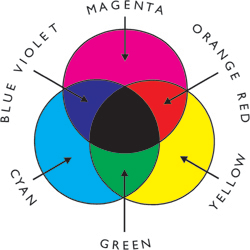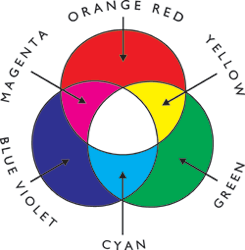The colour of light
Light itself is made up of light rays of different wavelengths. The colours of the rainbow are the result of breaking up light into these different
wavelengths by refraction. The various wavelengths can be combined to produce white light; this is known as 'additive' colour mixing. It is the
opposite of 'subtractive' colour mixing as with paint or pigments where the combination of all the different hues produces in theory black.
As with paint or pigments, white light can be created from three primaries. But these are as follows; blue-violet light, green light, and
orange-red light. The secondaries produced by mixing these light sources are magenta (from blue-violet and orange-red light), cyan
(from green and blue-violet light), and yellow (produced, believe it or not, by mixing green and orange-red light). A television picture is created
by the combination of many tiny dots of light in these primary colours.
If we regard for a moment the true primaries of subtractive colour mixing (as with paints or pigments) as being magenta, cyan and yellow then you
will see that these are the secondary colours when it comes to mixing light. Similarly the secondary colours in subtractive colour mixing are the
primary colours in mixing light. In other words everything is reversed. If you were to make a colour circle for mixing light, the centre of the
circle (where all the primary colours are mixed) would be white.

Subtractive colour mixing (paints or pigments)

Additive colour mixing (light)
Light from different sources tends to contain slightly more of certain wavelengths. For example daylight is more blue, whereas artificial light is
generally more yellow. This obviously has an effect on the visual appearance of colours, although most of the time the brain takes the distorting
effect of coloured light into account and we don't see any difference.
It can present a problem with colour photography though. A photograph taken indoors after dark with artificial lighting (without flash) may come out
looking yellow unless a colour correcting filter or special artificial light film is used, although digital cameras usually adjust the colour balance
automatically. This is obviously important when photographing paintings or artwork amongst other things.
The contrast between daylight and artificial light is most easily seen at the beginning and end of the day. This is because artificial light is
generally not as bright as daylight. At dawn and dusk the intensities of artificial and natural light are more likely to be equal. From outside at
this time, a lighted window appears noticeably yellow compared to the blue sky. From inside the light outside looks noticeably more blue than the
interior.
If you have daylight falling on a subject from one direction (such as from a window) as well as artificial light from another direction (such as
from a light in the room), the difference may be noticeable in the shadows, especially if the shadows are falling on a white surface. Where the
object blocks out the daylight the shadow will look yellowish (because here all the light is coming from the artificial light). Where the object
blocks out the artificial light the shadow will look blue (because here all the light is coming from the daylight).
The effect of coloured light on coloured surfaces
A coloured light will have an effect on the appearance of coloured surfaces. A coloured object will reflect wavelengths that correspond to its own
surface colour, and absorb the others.
Thus in the case of a blue-violet object under white light (which consists of a combination of orange-red, blue-violet and green wavelengths), it
reflects the blue-violet wavelengths but absorbs the orange-red and green wavelengths, making it appear blue-violet. If it is placed under a magenta
light (which consists of a combination of orange-red and blue-violet wavelengths), it reflects the blue-violet wavelengths but absorbs the orange-red
wavelengths, making it still appear blue-violet. However if it is placed under a yellow light (which consists of a combination of orange-red and green
wavelengths), it absorbs the orange-red and green wavelengths, which are the only ones reaching it, and thus no light is reflected, making it appear
black. Since electric light sources are often of a yellowish colour, anything of a blue-violet colour may not be seen in its true colours and care
should be taken in these circumstances.

Illustration of the effect of different coloured light on a coloured object
At sunrise and sunset the light is often noticeably orange-red, which has the effect of intensifying the yellow, orange or red colours in the
landscape.
To summarise, under a light of a particular colour, objects of the same colour will appear to be intensified, whereas objects of the complimentary
colour will appear dark or black.
Beware of drawing or painting in colour under conditions of low level artificial light. The yellow light will make violet appear black; until, that
is, you see the results in daylight!
The effect of coloured surfaces on each other
In addition to the effect of coloured light on surfaces, coloured surfaces will be reflected in each other. Bright coloured objects will reflect more
colour, and reflective surfaces will reflect more light in general. Thus an orange placed next to an apple, will reflect orange light onto the surface
of the apple, changing the apparent colour of the apple.





